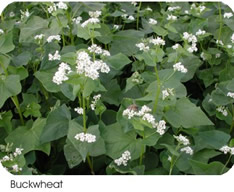By RACHEL IOVAN
Capital News Service
LANSING — As rainfall in Michigan gets increasingly severe and erratic, fertilizer prices skyrocket and concern grows over the environmental impact of agricultural run-off, many farmers are returning to an old technique that helps address all of those problems.

They’re planting cover crops — low-growing, mat-like plants, such as crimson clover, oilseed radish, winter wheat, cereal rye and cowpea that protect soil from the elements and aerate it.
More fruit and vegetable growers are using cover crops to improve soil quality, said Dale Mutch, a soil biologist at Michigan State University’s Kellogg Biological Station in Hickory Corners.
He said one retailer who supplies growers in Michigan sold a million more pounds of cover crop seed in 2010 than he did last year nationally, a sign that the crops are headed for a comeback.
Sieg Snapp, an MSU associate professor at the biological station, said cover crops provide oxygen to the soil and can, to some extent, replace fertilizer.
“Farmers are always trying to find ways to improve their soil,” said Snapp, and these crops are a good way to do that. “They can really improve the bang for your buck.”
He said cover crops are also of growing interest for organic farmers.
“It’s almost a requirement for organic farmers because they can’t use synthetic fertilizers,” said Mutch. That means that they rely on natural fertilizers, which are more expensive, so getting more out of less fertilizer is necessary.
Kable Thurlow, an MSU Extension educator for Clare and Gladwin counties, said farmers moved away from cover crops when fertilizer prices were low, but they’ve become more popular as fertilizer prices climb.
“It’s funny because it’s an old concept that was used by these farmer’s grandfathers and now it’s coming back again,” said Thurlow.
A recent informational meeting found that a majority of small growers in Clare and Gladwin counties use cover crops.
When Thurlow asked why as many larger growers don’t do the same, the participants said they couldn’t think of a reason.
Snapp said cover crops also minimize erosion.
“Michigan has been having more erratic rainfall and flooding,” said Snapp, “There’s been a tremendous amount of rain recently, which can wash away soil if it’s not protected.”
She said one of the most effective ways to control erosion, caused mostly by rain and wind is to grow something on it. Cover crops are especially useful in areas with sandier soil, like that found near Lake Michigan.
Mutch, who is also Michigan’s representative on the Midwest Cover Crops Council, said cover crops are potential grazing sources as well.
He described how a dairy farmer from the Upper Peninsula brought his cows to Southwest Michigan to graze on cover crops, while the grower used their manure to fertilize his crops.
Kenneth Blight, a beef, swine and corn farmer with 3,000 acres, said MSU soil researchers have been testing cover crops on a few of his acres for the past two years. The year after cover crops were grown on a stand, they planted corn on the same land.
“We had a tremendous yield the next year,” said Blight, “Even weed control was better.”
“It’s a good idea, but you don’t want to spend a ton of money to do it,” said Blight, who added that the costs seem more reasonable for smaller farms.
Mutch said equipment for planting cover crops can be expensive, so growers would welcome a future state or federal program to reduce their financial risk.
Blight said he’ll look into cover crops for his farm in the future after seeing the research results. His fields have nothing growing in them for nearly six months of the year, and cover crops could keep his fields covered for 11 months.
MSU’s Snapp said, “Many farmers only grow crops for three to four months in the year and the aim is to keep something growing for 11 months of the year.”
Matt McKimmy, an owner of McKimmy Farms in Beaverton, said his farm has been using cover crops extensively for the last two years and although he hasn’t seen many benefits yet, be he’s not discouraged because he knows results are long-term.
This season the farm planted cover crops on nearly half of its’ 2,000 acres.
Snapp said the U.S. Department of Agriculture and National Science Foundation have provided some cover crop grants.
“It’s important for policymakers and farmers to have a long-term understanding of the benefits,” said Snapp. She noted new studies are exploring the potential for cover crops as biofuels as well.
© 2010, Capital News Service, Michigan State University School of Journalism. Not to be reproduced without permission.
Spartan Newsroom - News and information from student journalists at the Michigan State University School of Journalism
Spartan Newsroom (https://news.jrn.msu.edu/2010/11/cover-crops-help-farmers-fight-erosion-and-improve-soil/)